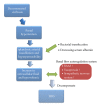The Relationship between Renal Dysfunction and Abnormalities of the Immune System in Patients with Decompensated Cirrhosis
- PMID: 23326675
- PMCID: PMC3541637
- DOI: 10.5402/2012/123826
The Relationship between Renal Dysfunction and Abnormalities of the Immune System in Patients with Decompensated Cirrhosis
Abstract
In patients with advanced cirrhosis, not only hepatocellular carcinoma but also bacterial infections, such as spontaneous bacterial peritonitis (SBP) or pneumonia, are frequent clinical complications in such immune-compromised patients. These pathologies often progress to renal dysfunction, especially hepatorenal syndrome (HRS). The central pathology of HRS is splanchnic arterial vasodilation and hyperpermeability followed by bacterial translocation (BT). BT induces a severe inflammatory response in the peritoneal lymphoid tissue, with the activation of the immune systems and the long-lasting production of vasoactive mediators that can impair the circulatory function and cause renal failure. Recent studies report that the plasma amino acid imbalance appeared to be related to an abnormality of the immune system in patients with decompensated cirrhosis. This paper can provide a new approach for future studies of the pathology in cirrhotic patients with renal dysfunction.
Figures





Similar articles
-
Complications of cirrhosis. II. Renal and circulatory dysfunction. Lights and shadows in an important clinical problem.J Hepatol. 2000;32(1 Suppl):157-70. doi: 10.1016/s0168-8278(00)80423-7. J Hepatol. 2000. PMID: 10728802 Review.
-
LEFT ventricular function assessed by echocardiography in cirrhosis: relationship to systemic hemodynamics and renal dysfunction.J Hepatol. 2013 Jan;58(1):51-7. doi: 10.1016/j.jhep.2012.08.027. Epub 2012 Sep 16. J Hepatol. 2013. PMID: 22989573
-
New Developments in Hepatorenal Syndrome.Clin Gastroenterol Hepatol. 2018 Feb;16(2):162-177.e1. doi: 10.1016/j.cgh.2017.05.041. Epub 2017 Jun 7. Clin Gastroenterol Hepatol. 2018. PMID: 28602971 Free PMC article. Review.
-
Clinical course and short-term mortality of cirrhotic patients with infections other than spontaneous bacterial peritonitis.Liver Int. 2017 Mar;37(3):385-395. doi: 10.1111/liv.13239. Epub 2016 Sep 20. Liver Int. 2017. PMID: 27558198
-
Prevalence of cirrhotic cardiomyopathy and its relationship with serum pro-brain natriuretic peptide, hepatorenal syndrome, spontaneous bacterial peritonitis, and mortality.Indian J Gastroenterol. 2020 Oct;39(5):481-486. doi: 10.1007/s12664-020-01083-2. Epub 2020 Nov 13. Indian J Gastroenterol. 2020. PMID: 33188455
Cited by
-
Immunologic, hemodynamic, and adrenal incompetence in cirrhosis: impact on renal dysfunction.Hepatol Int. 2015 Jan;9(1):17-27. doi: 10.1007/s12072-014-9581-1. Epub 2014 Sep 27. Hepatol Int. 2015. PMID: 25788375 Review.
References
-
- Kamath PS, Wiesner RH, Malinchoc M, et al. A model to predict survival in patients with end-stage liver disease. Hepatology. 2001;33(2):464–470. - PubMed
-
- Wiesner R, Edwards E, Freeman R, et al. Model for end-stage liver disease (MELD) and allocation of donor livers. Gastroenterology. 2003;124(1):91–96. - PubMed
-
- Arroyo V, Ginès P, Gerbes AL, et al. Definition and diagnostic criteria of refractory ascites and hepatorenal syndrome in cirrhosis. Hepatology. 1996;23(1):164–176. - PubMed
-
- Ginès P, Arroyo V. Hepatorenal syndrome. Journal of the American Society of Nephrology. 1999;10(8):1833–1839. - PubMed
LinkOut - more resources
Full Text Sources
